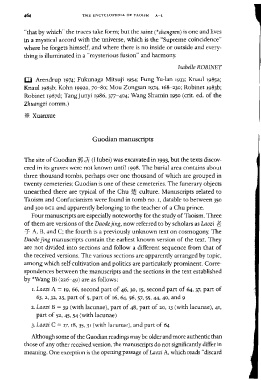Page 504 - The Encyclopedia of Taoism v1_A-L
P. 504
THE ENCYCLOPEDIA OF TAOISM A-L
"that by which" the traces take form; but the saint (*shengren) is one and lives
in a mystical accord with the universe, which is the "Supreme coincidence"
where he forgets himself, and where there is no inside or outside and every-
thing is illuminated in a "mysterious fusion" and harmony.
Isabelle ROBINET
W Arendrup 1974; Fukunaga Mitsuji 1954; Fung Yu-Ian 1933; Knaul I985a;
Knaul 1985b; Kohn 1992a, 70-80; Mou Zongsan 1974, 168-230; Robinet 1983b;
Robinet 1987d; TangJunyi 1986, 377-404; Wang Shumin 1950 (crit. ed. of the
Zhuangzi comm.)
* Xuanxue
Guodian manuscripts
The site of Guodian .$~m (Hubei) was excavated in 1993, but the texts discov-
ered in its graves were not known until 1998. The burial area contains about
three thousand tombs, perhaps over one thousand of which are grouped in
twenty cemeteries; Guodian is one of these cemeteries. The funerary objects
unearthed there are typical of the Chu ~ culture. Manuscripts related to
Taoism and Confucianism were found in tomb no. I, datable to between 350
and 300 BCE and apparently belonging to the teacher of a Chu prince.
Four manuscripts are especially noteworthy for the study of Taoism. Three
of them are versions of the Daode jing, now referred to by scholars as Laozi ~
:y: A, B, and C; the fourth is a previously unknown text on cosmogony. The
Daode jing manuscripts contain the earliest known version of the text. They
are not divided into sections and follow a different sequence from that of
the received versions. The various sections are apparently arranged by topic,
among which self-cultivation and politics are particularly prominent. Corre-
spondences between the manuscripts and the sections in the text established
by *Wang Bi (226-49) are as follows:
I. Laozi A = 19, 66, second part of 46, 30, IS, second part of 64, 37, part of
63, 2, 32, 25, part of 5, part of 16, 64, 56, 57, 55, 44, 40, and 9
2. Laozi B = 59 (with lacunae), part of 48, part of 20, 13 (with lacunae), 41,
part of 52,45,54 (with lacunae)
3· Laozi C = 17, 18,35,31 (with lacunae), and part of 64
Although some of the Guodian readings may be older and more authentic than
those of any other received version, the manuscripts do not significantly differ in
meaning. One exception is the opening passage of Laozi A, which reads" discard

